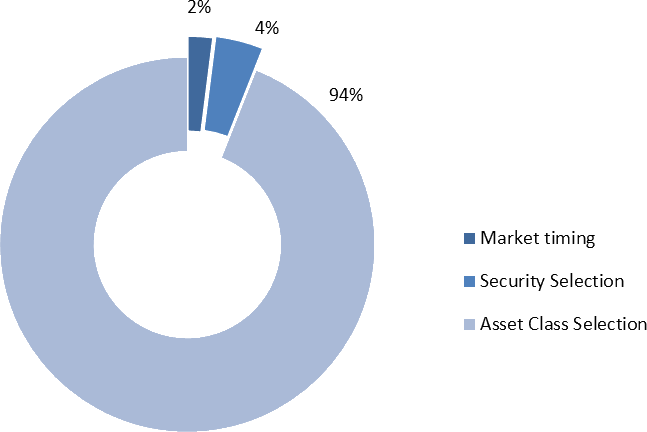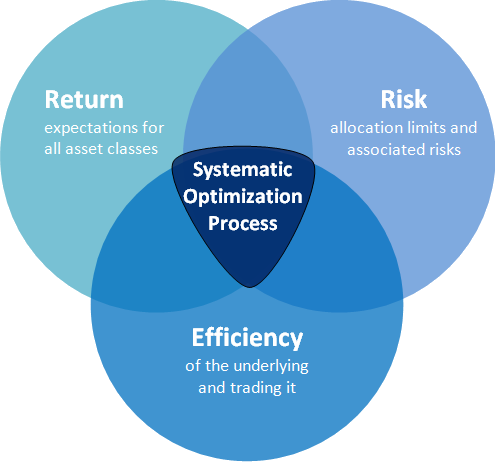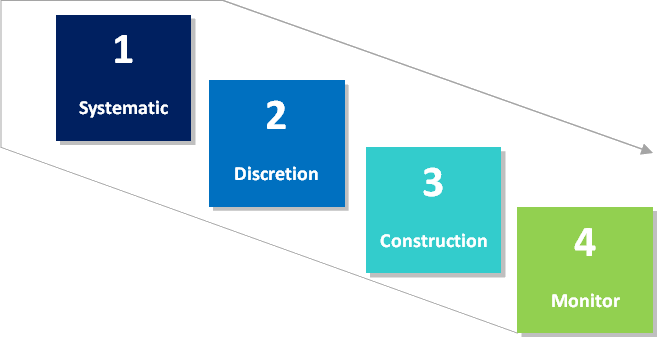Diversification across regions and asset classes is key since there is no asset class that consistently outperforms over time.
Why Asset Allocation?
Throughout history, academia and industry both confirm that asset class selection is the outmost contributor to overall portfolio performance. The following graph highlights Calendar year returns by asset class. It clearly illustrates how the top performers from 2001 until 2021 varied throughout the decades.
| 2001 | 2002 | 2003 | 2004 | 2005 | 2006 | 2007 | 2008 | 2009 | 2010 | 2011 | 2012 | 2013 | 2014 | 2015 | 2016 | 2017 | 2018 | 2019 | 2020 | 2021 | 2022 |
|---|---|---|---|---|---|---|---|---|---|---|---|---|---|---|---|---|---|---|---|---|---|
| Fixed income 8.4% |
Fixed income 10.3% |
Sm cap 47.3% |
Int'l 20.3% |
Int'l 13.5% |
Int'l 26.3% |
Lg cap growth 11.8% |
Fixed income 5.2% |
Lg cap growth 37.2% |
Sm cap 26.9% |
Fixed income 7.8% |
Lg cap value 17.5% |
Sm cap 38.8% |
Lg cap core 137% |
Lg cap growth 5.7% |
Sm cap 21.3% |
Lg cap growth 30.2% |
Cash 1.9% |
Lg cap growth 36.4% |
Lg cap growth 38.5% |
Lg cap core 28.7% |
Cash 1.5% |
| Cash 4.4% |
Cash 1.8% |
Int'l 38.6% |
Sm cap 18.3% |
Lg cap value 7.1% |
Lg cap value 22.3% |
Int'l 11.2% |
Cash 2.1% |
Int'l 31.8% |
Lg cap growth 16.7% |
Lg cap growth 2.6% |
Int'l 17.3% |
Lg cap growth 33.5% |
Lg cap value 13.5% |
Lg cap core 1.4% |
Lg cap value 17.3% |
Int'l 25.0% |
Fixed income 0.0% |
Lg cap core 31.5% |
Sm cap 20.0% |
Lg cap growth 27.6% |
Lg cap value -7.5% |
| Sm cap 2.5% |
Div portfolio -9.8% |
Lg cap value 30.0% |
Lg cap value 16.5% |
Div portfolio 5.4% |
Sm cap 18.4% |
Fixed income 7.0% |
Div portfolio -22.8% |
Sm cap 27.2% |
Lg cap value 15.5% |
Lg cap core 2.1% |
Sm cap 16.4% |
Lg cap value 32.5% |
Lg cap growth 13.1% |
Fixed income 0.6% |
Lg cap core 12.0% |
Lg cap core 21.8% |
Lg cap growth -1.5% |
Lg cap value 26.5% |
Lg cap core 18.4% |
Lg cap value 25.2% |
Fixed income -13.0% |
| Div portfolio -4.8% |
Lg cap value -15.5% |
Lg cap growth 29.8% |
Lg cap core 10.9% |
Lg cap growth 5.3% |
Lg cap core 15.8% |
Div portfolio 6.0% |
Sm cap -33.8% |
Lg cap core 26.5% |
Lg cap core 15.1% |
Div portfolio 1.8% |
Lg cap core 16.0% |
Lg cap core 32.4% |
Div portfolio 8.1% |
Div portfolio 0.1% |
Div portfolio 8.7% |
Div portfolio 15.1% |
Lg cap core -4.4% |
Sm cap 25.5% |
Div portfolio 14.7% |
Sm cap 14.8% |
Int'l -14.5% |
| Lg cap value -5.6% |
Int'l -15.9% |
Lg cap core 28.7% |
Div portfolio 10.5% |
Lg cap core 4.9% |
Div portfolio 13.0% |
Lg cap core 5.5% |
Lg cap core -36.9% |
Div portfolio 20.8% |
Div portfolio 13.0% |
Lg cap value 0.4% |
Lg cap growth 15.3% |
Int'l 22.8% |
Fixed income 6.0% |
Cash 0.1% |
Lg cap growth 7.1% |
Sm cap 14.7% |
Div portfolio -4.7% |
Int'l 22.0% |
Int'l 7.8% |
Div portfolio 13.9% |
Div portfolio -16.3% |
| Lg cap core -11.9% |
Sm cap -20.5% |
Div portfolio 23.5% |
Lg cap growth 6.3% |
Sm cap 4.6% |
Lg cap growth 9.1% |
Cash 5.0% |
Lg cap core -37.0% |
Lg cap value 19.7% |
Int'l 7.8% |
Cash 0.1% |
Div portfolio 12.2% |
Div portfolio 20.3% |
Sm cap 4.9% |
Int'l -0.8% |
Fixed income 2.7% |
Lg cap value 13.7% |
Lg cap value -8.3% |
Div portfolio 22.0% |
Fixed income 7.5% |
Int'l 11.3% |
Lg cap core -18.1% |
| Lg cap growth -20.4% |
Lg cap core -22.1% |
Fixed income 4.1% |
Fixed income 4.3% |
Cash 3.1% |
Cash 4.9% |
Lg cap value -0.2% |
Lg cap growth -38.4% |
Fixed income 5.9% |
Fixed income 6.5% |
Sm cap -4.2% |
Fixed income 4.2% |
Cash 0.1% |
Cash 0.0% |
Lg cap value -3.8% |
Int'l 1.0% |
Fixed income 3.5% |
Sm cap -11.0% |
Fixed income 8.7% |
Lg cap value 2.8% |
Cash 0.1% |
Sm cap -20.4% |
| Int'l -21.4% |
Lg cap growth -27.9% |
Cash 1.2% |
Cash 1.3% |
Fixed income 2.4% |
Fixed income 4.3% |
Sm cap -1.6% |
Int'l -43.4% |
Cash 0.2% |
Cash 0.1% |
Int'l -12.1% |
Cash 0.1% |
Fixed income -2.0% |
Int'l -4.9% |
Sm cap -4.4% |
Cash 0.3% |
Cash 0.9% |
Int'l -13.8% |
Cash 2.3% |
Cash 0.7% |
Fixed income -1.5% |
Lg cap growth -29.1% |
Scroll to see previous and nexts years.
Key determinants of portfolio performance
In the previous years, sophisticated investing solutions were limited to the institutional level; now these are broadly available.
Globally, investors are moving away from products that offer limited investment opportunities and towards a model, or a “whole portfolio” approach.
Today, any person that wishes to invest has access to a diversified Model Portfolio Solution through our digital platform.

Our Model Portfolios
Our model portfolios are designed and managed in partnership with BlackRock®’s Model Portfolio Solutions. The purpose of these model portfolios is to deliver efficiency, transparency, and cost effectiveness. The selected UCITS ETFs that are part of the Model Portfolios are designed to meet specific goals such as global diversification, tactical exposures, and tax efficiency. The implementation procedure guides each individual investor on how to invest in the most appropriate vehicle for their profile. The vehicle selection process is primarily driven by exposure, efficiency, and cost; leveraging more than 300 UCITS ETFs.
BlackRock®'s portfolio construction process
The variables in the systematic optimization process are Return-Risk-Efficiency.

The Model Portfolio Solutions (MPS) Construction is a simple four-step process that leverages the entirety of BlackRock®’s technology and risk platform.

How We Invest?
Methodology
Risk Capacity
When you open your account, we ask you a few questions so we can determine your attitude towards risk and risk tolerance, investment knowledge and objectives, your net worth, time horizon and liquidity needs.
Investment Vehicles
In order to create globally diversified portfolios, the Model Portfolios use across-the-board uncorrelated asset-classes. In order to accomplish this, it only uses UCITS ETFs. Regularly, the universe of UCITS ETFs in the Model Portfolios is reviewed to identify the most appropriate ones to represent each of the asset classes. The Model Portfolios include the UCITS and ETFs that offer market liquidity, minimize tracking error and are tax efficient.
Asset Allocation
Based on the systematic investment process and after an in-depth analysis on each asset class, together with BlackRock® we determine the optimal mix for your portfolio to generate a return at the lowest risk. The objective is to create an asset allocation that produces the maximum possible return while respecting your particular risk tolerance. Translating investor outcomes and restrictions into globally well-diversified allocations: Return – Risk – Cost.
Monitoring and Rebalancing
To keep portfolios in track with long-term goals, the Model Portfolios are monitored and regularly rebalanced back to its target mix in an effort to optimize returns for their intended level of risk.
Why Only UCITS ETF's?
A UCITS ETFs is a security that usually tracks a basket of stocks, bonds, or assets like an index fund, but trades like a stock on a stock exchange. They closely track their benchmarks, such as Dow Jones Industrial Average or the S&P500. They provide great diversification, offer ample liquidity, and are tax efficient for investors who do not reside in the U.S.
Definite Mandates
We only use UCITS ETFs that have a definite mandate to passively track benchmark indexes. This restricts the fund manager to simply replicate the performance of the benchmark they follow and ensures the same level of investment diversification as the benchmark itself.